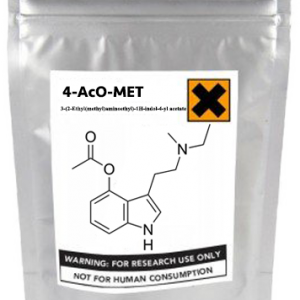Buy 4-ACO-MET Online
4-aco-met or psilacetin is a synthetic psychedelic tryptamine. 4-aco-met is similar to the “magic mushroom” molecules psilocybin and psilocin.
Albert Hofmann, along with Franz Troxler, for Sandoz Ltd. invented 4-aco-met. Sandoz Ltd company patented the drug in 1963 (incidentally the same year their LSD patents expired).
Of the many “grey market” research chemicals out there, 4-aco-met is probably among the safest. At macrodoses, its effects are comparable – although in some ways rather different – to those of psilocybin or psilocin. Most users report a full range of psychedelic visual effects, from color enhancement to vivid hallucinations, along with euphoria, ego loss, and mystical or religious experiences.
Effects of 4-aco-met
And, as with psilocybin, microdoses have been linked to:
- Increased empathy and sociability
- Introspection
- Mood enhancement
- Visual clarity and color enhancement
- Motivation and energy
- Relaxation, peace, and contentedness
- Mental clarity and focus
Chemistry and Pharmalogy of 4-aco-met
4-aco-met is also known as O-Acetylpsilocin; that is, the O-acetylated form or ester of psilocin (4-HO-DMT) – psilocybin (4-PO-DMT) being the O-phosphorylated form. In other words, 4-AcO-DMT has the same basic structure as both psilocin and psilocybin, but with an acetoxy group bonded to its indole ring.
Like psilocybin 4-ACO-MET and 4–AcO-DMT considered a prodrug of psilocin, converting into the latter through metabolism by the body. Pharmacologist David Nichols even went so far as to advocate its replacement of psilocybin in psilocin research, since 4-AcO-DMT is by far the easier ester to synthesize.
The prodrug theory is not without its critics, however. According to some, the immediate psychoactivity of 4-AcO-MET when injected or smoked (i.e. when bypassing the metabolism), as well as its higher average dose than psilocin, suggests the compound is uniquely psychoactive in its own right and not just, or even necessarily, as a metabolic precursor to psilocin.
There are subjective differences too. While some consider the effects of 4-AcO-MET to be identical to those of
Given its chemical similarities to psilocin, though, we can safely assume that 4-AcO-MET roughly the same mechanism of action – primarily activating the 5-HT2A serotonin receptors.
Science of 4-aco-met
Much of what we understand about how psychedelics work involves serotonin, a chemical that keeps our brains ticking. It is one of the most important neurotransmitters, affecting nearly everything we do. From how we feel to how we process information.
Indeed, much like other classical psychedelics (including LSD), psilocybin, psilocin, and 4-aco-met actually share a similar molecular structure to serotonin. SSRI (selective serotonin reuptake inhibitor) antidepressants work to alleviate low mood by increasing serotonin levels in the brain. 4-aco-met would be expected to work more directly by actually mimicking serotonin itself, and stimulating serotonin receptors.
The stimulation of the 5-HT2A receptor in particular has two very important results:
- The production of “Brain Derived Neurotrophic Factor” (BDNF). BDNF is “like Miracle-Gro for your brain. It stimulates growth, connections, and activity.”
- The increased transmission of “Glutamate.” Glutamate is the neurotransmitter most responsible for brain functions like cognition, learning, and memory.
Another thing the classical psychedelics are capable of doing is causing parts of the brain that wouldn’t usually communicate with one another… to communicate with one another!
Visit other products like; 2c-b, 5-meo-mipt,4 aco dmt





